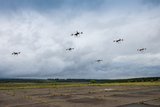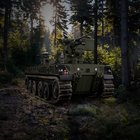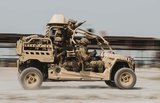Global Hawk earns an additional Military Airworthiness Certification
Northrop Grumman Corporation announced the US Air Force has granted the RQ-4 Global Hawk high-altitude, long-endurance (HALE) unmanned aircraft system (UAS) a military Airworthiness Certification (AWC), a significant milestone in the life of the aircraft system and a step on the path to routine unmanned flight within the United States.
The AWC process verifies an aircraft design has met performance requirements within the mission profile to safely fly in national airspace and assures operators and mission managers that the production articles conform to the design. In granting the certification to RQ-4, the next generation of Block 20 and 30 Global Hawk UAS, the US Air Force has recognized the aircraft's ability to routinely fly safely within design parameters. The certification process evaluated more than 600 airworthiness criteria.
"This was a more rigorous and more complete evaluation than that of any other unmanned system," said George Guerra, vice president of HALE systems for Northrop Grumman. "With this historic accomplishment and more than 35,000 total flight hours, most of that time in combat support over the skies of Iraq and Afghanistan, Global Hawk continues to be a trailblazer in UAS certifications and a pathfinder supporting our men and women overseas in combat."
Just as commercial aircraft are certified by the Federal Aviation Administration (FAA), military aircraft are evaluated against certain criteria including durability, capability to adjust to sudden changes in aerodynamic forces, and redundancies of systems and subsystems. Without this Air Force certification, the FAA cannot grant permission to fly within the United States, which is the next step in the on-going process to accept the routine flight of unmanned aircraft in the national airspace.
"This certification resulted from a large collaborative effort between the government and the contractor, agreeing on standards and verification methods and ultimately coming together on the assessment of the system. With its Advanced Concept Technology Demonstration legacy design and early push to support Overseas Contingency Operations and U-2 retirement, this was the first comprehensive assessment of the aircraft to ensure it is ready to fly in national airspace and ready for the user to train with at Beale AFB," said Yvette Weber, chief engineer at the 303d Aeronautical Systems Group at Wright Patterson AFB in Dayton, Ohio.
The certification is the latest example of success for the Northrop Grumman Global Hawk program. In 2006, the Block 10 version, or RQ-4A, made history when it became the first UAS to earn both a military airworthiness certification and a national certificate of authorization to operate in the national airspace. This airworthiness certification covers all Block 20 and Block 30 Global Hawks delivered to the US Air Force thus far.
Global Hawk flies autonomously at altitudes of more than 60,000 feet, above inclement weather and prevailing winds, for more than 32 hours at a time. The first-generation experimental Global Hawks deployed overseas to the Persian Gulf less than two months after Sept. 11, 2001. Since then, Block 10 Global Hawks have been flying nearly continuously, supporting combat operations in the region. The Block 20 and 30 systems, capable of carrying 50 percent more payload with improved sensors, are scheduled to begin operations with the US Air Force at Beale Air Force Base, Calif., and at several overseas locations, next year.
Recently, the Block 20 aircraft system was chosen to be modified with special communications relay equipment to support coalition combat forces in Afghanistan. The Block 30 Global Hawk carries sophisticated imaging and electronic signals sensors on missions that can exceed 30 hours. A similar certification will be granted in the near future for the Block 40 system, which is based on the same aircraft design of Block 20 and 30 but carries an advanced radar imaging and ground moving target tracking system used to track enemy movement, regardless of weather conditions on the ground.
More from Uncrewed Vehicles
-
![Ready for the race: Air separation drone swarms vs. air defence systems]()
Ready for the race: Air separation drone swarms vs. air defence systems
As the dynamics of aerial combat rapidly evolve, Chinese scientists have engineered a sophisticated air separation drone model that can fragment into up to six drones, each capable of executing distinct battlefield roles and challenging the efficacy of current anti-drone defences such as the UK’s Dragonfire laser system.
-
![Israel’s MALE UAVs ‘must adapt’ to Iranian-made air defences]()
Israel’s MALE UAVs ‘must adapt’ to Iranian-made air defences
Advancements in air defence technologies have begun to reshape aerial combat dynamics in the Middle East, as illustrated by recent events involving the Israeli Air Force and Hezbollah.
-
![Hundreds more UAS sent to Ukraine forces with thousands more on the way]()
Hundreds more UAS sent to Ukraine forces with thousands more on the way
Both sides of the Russia-Ukraine war have been using UAS for effective low-cost attacks, as well as impactful web and social media footage. Thousands more have now been committed to Ukrainian forces.
-
![AI and software companies selected for US Army Robotic Combat Vehicle subsystems]()
AI and software companies selected for US Army Robotic Combat Vehicle subsystems
The US Army has intentions to develop light, medium and heavy variants of the Robotic Combat Vehicle (RCV) as part of the branche’s Next Generation Combat Vehicle family.
-
![DroneShield to improve software of DroneSentry-X C-UAS system under new contract]()
DroneShield to improve software of DroneSentry-X C-UAS system under new contract
DroneSentry-X, a cross-vehicle compatible, automated 360° C-UAS detect and defeat device, can offer 360° awareness and protection using integrated sensors. According to its manufacturer, it is suitable for mobile operations, on-site surveillance and on-the-move missions.
-
![Ukraine takes delivery of new indigenous C-UAS systems]()
Ukraine takes delivery of new indigenous C-UAS systems
Funded by the country’s former president, the new C-UAS systems will be sent to the frontline where they have already been tested against Russian invading forces.


























